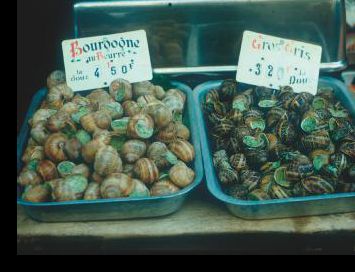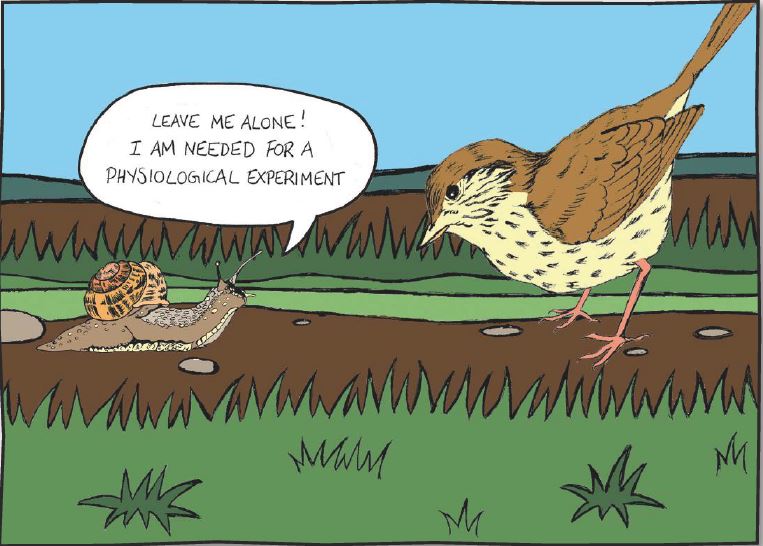
Physiology News Magazine
Editorial: Invertebrates as experimental animals
News and Views
Editorial: Invertebrates as experimental animals
News and Views
Roger Thomas
Editor, Physiology News
https://doi.org/10.36866/pn.99.5
This issue features articles on invertebrate physiology. I was myself introduced to the snail brain for my PhD studies at Southampton University, where my supervisor Gerald Kerkut was inspired by a 1960 paper (in French) by Tauc and Gerschenfeld concerning cholinergic transmission in the CNS of ‘l’Escargot’, which we took to be either Helix aspersa or pomatia. (The two species are shown in the picture adjacent taken by me in Paris in the year of student unrest, 1968). The zero cost, and minimal upkeep needs, of land snails were also a factor. Since snails are so easy to maintain the Head of Department gave me the additional duty (times were hard and the department had few staff) of looking after the department’s crabs, collected weekly from the local power station intake. To enable me to be away for the weekend, I had to double their sea-water filter capacity. Otherwise they overflowed. It taught me useful plumbing skills I suppose.
Neurophysiological research on molluscs was greatly stimulated by J.Z. Young’s in the 1930s. He realised that what had been thought to be a blood vessels in the squid mantle were in fact giant axons. Hodgkin and Huxley exploited this preparation brilliantly, and many others since have focussed on it. Other molluscs too have a long history as experimental animals. The sea-slug Aplysia, like snails, has very large and colourful nerve cells, and these were widely used 50-30 years ago for a variety of basic studies. The introduction of the Aplysia nervous system to study the cellular and molecular basis of organized neuronal interactions has been described as one of Tauc’s essential contributions to neuroscience. Specimens from California were (of course) much larger than European specimens. There was a time when labs in Paris imported Aplysia from California by air, and took advantage of the separation between ganglia to make several preparations from one animal.
In those early days crustacean muscles and nerves were also popular. Indeed the first discovery that GABA and Glutamate were synaptic transmitters of inhibition and excitation were made using crustacean preparations, notably the crustacean stretch receptor. Alas I have been unable to include in this issue anything about recent crustacean research, but readers keen to look into this should read Harold Atwood’s chapter in Volume 3 of The Natural History of the Crustacea, edited by Derby and Thiel. OUP, published in 2014. The articles I have included cover nematodes, leeches, snails, flies, spiders and tunicates. Many other classes of invertebrate have been investigated by physiologists, of course, but we have too little space to do them justice.

Mammalian preparations are much more widely used now. The invention of the whole-cell patch clamp method in the early 1980s allowed single-cell recording from much smaller cells than before. Over the same period the development of methods of cutting and nurturing viable slices of parts of mammalian brains and culturing isolated neurones led to many neurophysiologists working on mammals instead. Grants are easier to obtain, since relevance to human physiology is more convincing. Previously, sharp microelectrodes had to be pushed through the cell membrane to record membrane potentials, inevitably creating an often-fatal leak. As pioneered by Eccles in the 1950s large cells such as mammal motoneurones could tolerate this method, but smaller cells could not. The whole-cell patch clamp involves a smooth-tipped electrode being gently sucked onto the clean cell membrane to make a seal, then the membrane under the electrode tip being broken by a pressure pulse to gain access to the cell interior. The cost of mammals, however, in bureaucracy and animal house fees is considerable. Land snails cost nothing, and other invertebrates are relatively cheap. And there are advantages to the relative simplicity and short generation time of many invertebrate systems, as the various contributors explain. This applies particularly to Drosophila, whose genetics have been investigated for over a century. Whereas the move in the 1990s was from invertebrate to mouse, the high cost of the latter is driving a move back to flies. Since research grants are likely to be harder to obtain in the UK in future, one might hope that money is saved by experimenting on flies. No licence is required, either.
I write this after the opinion pollsters have been discredited by the UK election result. This new Conservative government may lead to Scotland leaving the UK, but following the precedent of Irish independence in 1922, The Physiological Society will not need to change. It is not as if its official name includes any geographical element. The objects of The Society do include the term ‘at home and abroad’, but as far as I can see membership is not restricted at all. It is open to ‘those persons who are interested in Physiology in accordance with requirements determined by Council and shall be eligible…’ Standing order B1(d) sets out the criteria, which do not include any nationality or residential restrictions. On the other hand I suspect Charity Commission and/or Companies House rules require at least the Annual General Meeting to be held in the British Isles.
I end by repeating the plea made frequently by my predecessors, to urge you the reader to offer material for publication. Letters to the editor, articles featuring a topical problem, comments, reports etc. Suggestions, books to review, jokes, cartoons, even ideas for cartoons will be welcomed. I am even prepared to publish negative comments if phrased tactfully. Letters and emails not for publication will also be read, cautiously.

